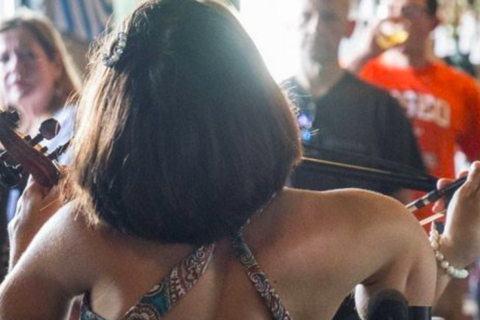The benefits of accommodating and encouraging limb-different string students far outweigh the challenges for teachers, says University of North Texas lecturer Elizabeth Chappell

Just recently a three-year-old without arms was in a restaurant and was asked not to use his feet to feed himself. The story went viral and many were outraged that anyone would discriminate against him in that way. For most with typical limbs it’s hard to imagine having the toe and foot dexterity needed to pour syrup or use a fork. Yet at three he had this dexterity. Nevertheless, the restaurant discouraged him from using these skills because it was outside the norm.
Like eating, music making has been a vital part of the human experience in every culture since recorded time. Someone who uses their feet to perform tasks that others typically perform with their hands need put no more effort into beginning a stringed instrument than any other task, especially with the support of an open-minded teacher.
Accommodations for limb differences will require more effort on the part of the teacher, but the advantages far outweigh the minor inconveniences inclusion may present. For limb-different students, learning an instrument is a chance to find a musical ‘voice’ and to participate in socially normative experiences. For teachers, such inclusion provides an opportunity to examine string pedagogy from a new angle, deepening our understanding of the effectiveness of our tried-and-tested techniques. For classmates, seeing accommodations put into use can demonstrate problem solving in action, and the limitless possibilities that are available to us when we put our creative minds to work – not to mention the exposure to the innovation and unique musical voices of students with diverse experiences.
If you are wondering how to get started with a limb-different student, you should first observe them performing basic tasks and get an idea of their capabilities
I became interested in string pedagogy for people with limb differences when I heard Gaelynn Lea, the winner of the 2016 NPR Tiny Desk Contest. I enjoyed her sound, and as a string music educator I was curious about her story. When I attended her live performance, she opened with an anecdote about her experience in her school orchestra, and described how a teacher had helped her settle into a violin technique that looked similar to a cello position and a German double bass bow hold. ‘We in the orchestra were all in it together,’ she said of this experience, ‘and we probably all kind of sucked.’ It struck me that although her technique was vastly different from that of typical string players, her experience was not unlike what most of us go through when starting a school orchestra. When I wasn’t wrapped up in her stellar performance, I was fascinated by the way that she solved each potential issue. For example, Lea was able to use her feet to rotate the violin slightly as she changed strings, which then allowed her to get a clear sound and full usage of her bow on each string. To see and hear Lea performing, visit her website (violinscratches.com).
Other musicians with limb differences whom you could look up are Adrian Anantawan, Inga Petry, Michael Spencer and Tad Lietz. If you are wondering how to get started with a limb-different student, you should first observe them performing basic tasks and get an idea of their capabilities. Analyse the tasks that will require accommodations and experiment with the simplest solutions first. In other words, constructing a robotic arm would be at the end of your list of things to try.
Consult with the student, the parents, former teachers, and occupational or physical therapists to utilise past experiences and solutions. As with all of your students, the teaching journey will be a unique opportunity for growth. Why should we as teachers support instruction for limb-different string students in our studios and classrooms? Quite simply: because we can. As teachers, we must be willing to welcome all students into the circle of humanity. Music is for all.










































No comments yet